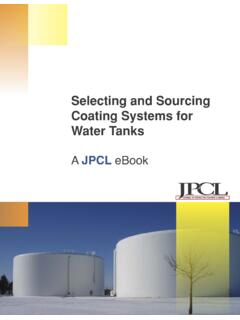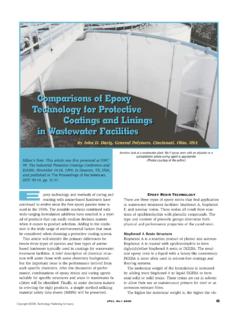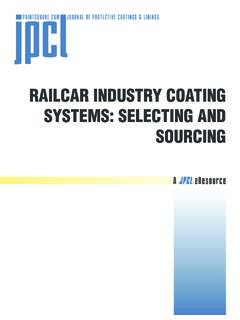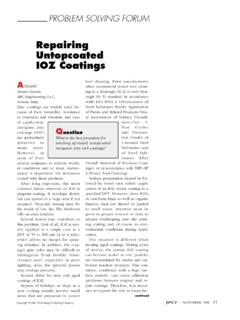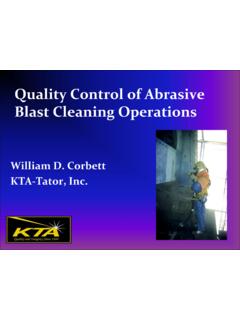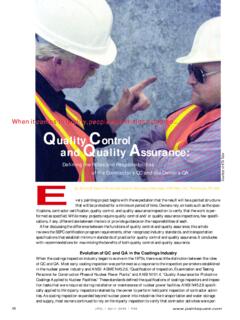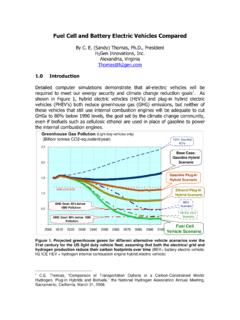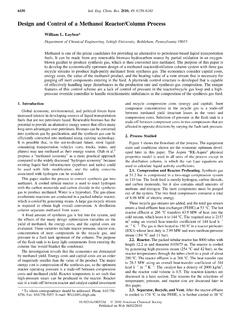Transcription of Ship Painting: Current Practice and Systems in Europe
1 PCE September 199824 Copyright 1998, Technology Publishing Companys long as shipssail the seas, they will need protec-tion from the corrosive environmentin which they article presents an overviewof Current Practice in the selectionand use of marine coatings. It looksat recent developments in coatingsystems for ships and describes themost critical parts of a ship forcoating protection, including theunderwater/boottop areas, ballasttanks, and cargo tanks . Particularattention is given to the role of anti-corrosive and antifouling systemsfor the underwater hull and boottopareas and recent developments inantifouling protection. Also includ-ed are other areas of a ship such asthe topside and superstructure andthe decks. At the outset is a summary ofcurrent shipbuilding practices ,including the role of shop primersand methods of painting a ship dur-ing assembly.
2 COMMON METHODOF SHIPBUILDING Current shipbuilding Practice isto clean the steel in a centrifugalblasting machine and then imme-diately apply a weldable shopprimer. This process is mechanical treatments,such as rolling flat, cutting to size,bending, stretching, and drilling,the shop-coated plates and profilesare welded into block sections,which are transported to the slip-way for earlier days, many yardsnow build ships completely undercover. Consequently, the yards areless dependent on the climate,which is a considerable advantagefor preventing premature corrosionduring construction. It also meanssecondary surface preparation ( ,cleaning of corroded areas, welds,or damaged and burned areas) islimited, and since power tool clean-ing can be used for this purposeinstead of total blasting, the resultis less dust emission and consider-able savings of BerendsenCoatings ConsultantMoordrecht,The NetherlandsAShip painting : CurrentPracticeand Systemsin EuropeThe underwater hull and boottop are among the most critical areas of a ship for painting .
3 (Photos courtesy of Camrex Chugoku Ltd.) have little or no effect on thehomogeneity and strength of welds; not emit noxious or toxic fumesduring welding and flame cutting (asafety certificate is required); be able to withstand roughmechanical handling of the steel,including bending; be suitable as the base for thefinal coating Systems ; be highly resistant to water andcompatible with cathodic protectionsystems (resistant to alkaline condi-tions); have no adverse effects on theenvironment during application anduse; and be approved by classification dry film thick-ness (DFT) of shopprimers is a compro-mise between variousrequirements ( ,weldability, limit ofwelding fumes, weldquality, and dryingtime), which allrequire less thickness,and corrosion protec-tion, which requiresmore thickness.
4 Theprescribed DFT formost shop primers is15-25 shipbuilding, the most com-mon types of shop primer now arebased on unsaponifiable binders,such as two-component epoxyresins and partially hydrolysed ethylsilicates. Reinforced wash primersbased on polyvinyl butyral/phenolicresins are no longer used becausethey contain chromate, which pro-duces hazardous fumes duringwelding or cutting, and becausethey are not fully compatible withcathodic protection shop primers are pigment-ed mainly with iron oxide andShop Primers The main function of a prefabri-cation, preconstruction, or shopprimer is to protect steel againstcorrosion and pollution duringthe building stage. It usually func-tions as a base for the final coat-ing system . However, it some-times is removed by blasting first,such as when the steel has cor-roded during construction orwhen the shop primer is tooweathered to form a solid basefor the coating Systems .
5 In cargotanks for aggressive chemicals, ashop primer must be removed toensure full chemical resistance ofthe final coating primers should meet the fol-lowing requirements:1 provide adequate corrosion pro-tection during shipbuilding; be sprayable in a continuous thinfilm of uniform thickness; have a very short dry-to-handletime for transportation of steel partsby conveyor rollers, magneticcranes, or vacuum hoists withoutdamage to the primer; be fully compatible with advanc-ed welding/cutting processes (thereshould be no need to remove theshop primer first, and it should notaffect the speed of these processes); active corrosion-inhibiting pig-ments, such as zinc and calciumphosphates. Zinc (potassium) chro-mate, which has better anticorro-sive properties, is generally nolonger used in Europe and otherparts of the world because of therelease of dangerous fumes duringwelding and because it could formblisters in underwater silicate shop primers arepigmented with zinc dust, which isadded to the binder solution shortlybefore application.
6 Most of theseproducts are not zinc-rich but havea reduced zinc content. This isnecessary for satisfactory perfor-mance in automatic, semiautomat-ic, and robotic welding , primers with a reducedzinc content produce less haz-ardous fumes during welding andalso less zinc salts during weather-ing, which means less risk ofosmotic blistering. Consequently,they provide better recoatability. Reducing the zinc content alsoreduces the corrosion-inhibitingproperties, but they generally aresufficient to protect steel duringbuilding, especially because manyships are built under cover. How-ever, the best option would be todevelop a zinc-rich shop primerwith good automatic weldingproperties or to develop a suitableautomatic welding method for suchprimers. Since epoxy shop primers havean organic binder, they generatelarge amounts of fumes duringwelding and flame-cutting, whichcan burn a large area of primer inthe process.
7 In addition, large heat-affected zones adjacent to the burntareas and on the back of the steelare an unreliable base for a paintsystem. Therefore, these areas mustbe thoroughly pretreated again (sec-ondary surface preparation) by25 PCE September 1998 Copyright 1998, Technology Publishing CompanyAn aesthetic topcoat usually is applied to the topside andsuperstructure for good 1998, Technology Publishing Companya ship , they are painted in one oftwo ways: as soon as possible after assem-bly, partially or completely (the block painting or paint-then-weld method), in which eachblock is painted prior to welding ofthe blocks to form the ship struc-ture, or after a long period, , aftererection on the slipway (the build-ing in the shop coat or weld-then-paint method), in which theshop-coated blocks are welded intothe ship structure and painted main advantages of blockpainting are that premature corro-sion and weathering of the shop-primed surfaces are avoided andthat the final coating Systems canbe applied under cover.
8 In theory,block painting allows shipbuildersPCE September 199826blasting or power tool silicate shop primers, whichare totally inorganic after curingand very heat-resistant, show lessdamage around welds and , they need less secondarysurface preparation, which limitscosts. These facts, coupled withtheir better resistance to cathodicprotection, explain the popularity ofzinc silicate shop an effort to decrease the usual-ly high levels of volatile organiccompounds (VOCs) found in shopprimers, water-borne productsbased on alkali silicate or epoxyresin emulsion have been devel-oped, but they have not yet foundwide and PaintingAfter assembly of the sections ofto take control of their environmentand to handle advanced solvent-freeand water-borne Systems , even inwinter. In Practice , however, ifbuilding halls are not climate-con-trolled, delays may be expected aftera change in the weather when nocoating work can be done for sever-al days because of main disadvantage of blockpainting is a risk of mechanicaldamage and burns during transportof the sections to the slipway andduring fitting-out.
9 However, thisdamage can be minimised by ade-quate planning during the con-struction phase. Subsequent pre-treatment and painting of the sec-tion welds is unavoidable, ofcourse, and these areas must be leftunpainted during block damage of the finalpaint Systems plays no role whenbuilding in the shop coat. The maindisadvantage of building in theshop coat is that shop-coated steelis subject to weathering and corro-sion during construction of theship. Another disadvantage is thatfinal painting must be done in alate stage of the building may be more difficult from anaccessibility viewpoint, or it may beundesirable with respect to otheractivities or the spreading of paintdust. However, building ships in theshop coat completely under coverminimises corrosion considerably. COATING SYSTEMSThe most important recent devel-opments in coating Systems forships have resulted from increasingregulations on the use of hazardousraw materials and the prevention ofenvironmental pollution.
10 Seekingbetter performance and economicadvantages have also played impor-Keywords Epoxy mastic: a surface-tolerant modified high-solids epoxy coating suitablefor application over aged coatings High-build coating: a coating that can be applied in thick layers without sag-ging on vertical surfaces High-solid(s) coating: a coating with a reduced level of solvents classified asvolatile organic compounds (VOCs), which contribute to air pollution Interval-free epoxy coating: a modified epoxy coating that does not have alimited overcoating time Modified epoxy coating: a coating based on an epoxy resin that is modified withanother binder ( , a coal tar or hydrocarbon resin) to make a less expensivecoating or to improve properties like water impermeability or recoatability Reinforced coating: a coating that has special materials added, such as hardfillers or glass flake, to improve abrasion resistance, mechanical strength, flexi-bility, impermeability, or other properties Solvent-free coating: one that in principle contains no VOCs but in practiceoften has a very low level of VOCs, perhaps 1 2% by volume Solventless coating: one that has a low level of VOCs ( , not more than 5%by volume) Surface-tolerant epoxy coating.
